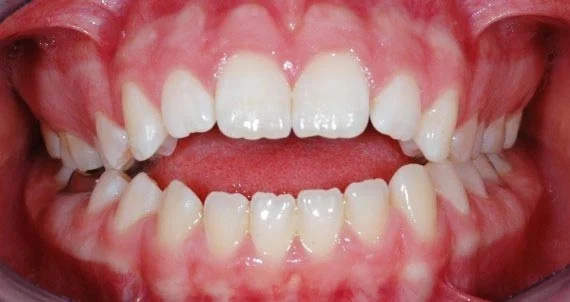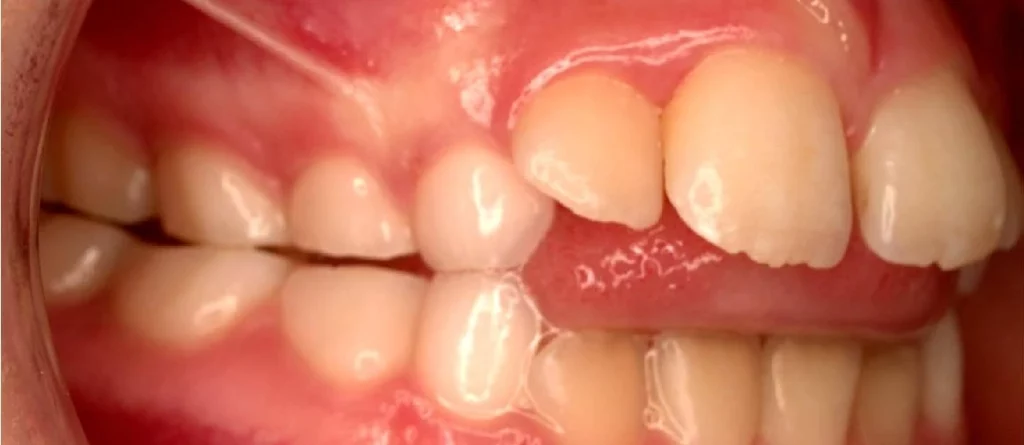In this article, you will learn about tongue thrust or protrusion of the tongue. The tongue is an organ that performs multiple functions during chewing, breathing, swallowing, and speaking. The muscles that compose it are in constant use, which is why, although it is such a small organ compared to others, it is known to be the strongest in the human body.
Swallowing is the act by which food and saliva pass from the mouth to the stomach and is something done between 1,000 and 2,000 times a day. On some occasions, this process does not happen in the normal way when atypical swallowing appears.
What is Tongue Thrust?
This is an oral habit, in which the tongue exerts constant pressure on the front teeth when speaking, swallowing food, or passing saliva. It puts pressure on the sides of the mouth, affecting the teeth furthest back.
The thrust of the tongue can be divided into 2 stages:
1. Tongue thrust in babies (up to 6 months of age)
In babies, before the first teeth appear, a normal type of swallowing is observed: babies place their tongues on their gums to swallow, and since there are no teeth, it poses no problem.
2. Tongue thrust in children and adults
Since the first teeth emerge, it is normal that during the swallowing process, the tongue touches the palate and then descends to promote the passage of the food bolus toward the pharynx.
When the child grows up and the habit of tongue protrusion persists, it can cause multiple effects on the normal development of occlusion, speech, and breathing. Tongue thrusting, a habit where the tongue pushes against the front teeth during swallowing, can have a significant impact on dental health. This repetitive pressure on the teeth over time can result in misalignment or crooked teeth.
How is the Habit of Pushing the Tongue Classified?
The protrusion of the tongue can be classified into 6 groups and depending upon the habit’s level of severity, it can also cause various dental anomalies:
• Type I or non-deforming tongue thrust: The habit does not cause damage or considerable changes in the mouth.
• Type II or anterior deforming tongue thrust: The habit causes anterior open bite, protrusion of the anterior teeth, or crossbite posterior.
• Type III or lateral deforming tongue thrust: The habit causes posterior open bite, posterior crossbite, or a deep overbite.
• Type IV or anterior and lateral deforming tongue thrust: The habit causes anterior and posterior open bite, protrusion of the anterior teeth, and posterior crossbite.
What are the Signs of protrusion of the tongue?
In addition to dental abnormalities, this habit can cause:
• Deep palate
• Speech problems: orofacial myofunctional disorders (OMDs)
• Problems chewing
• Open lips and incorrect position of the tongue when at rest
Why does this Habit Occur? What Causes it?
Protrusion of the tongue can be caused by several factors:
Sucking habits
• The finger
• The bottle or pacifier after the age of 4 or 5 years
Anatomical conditions in the mouth
• Tractioning tongue-tie or ankyloglossia
• Large tonsils
• Narrow palate
• Very large tongue
Environmental factors
• Allergies
• Congestion and difficulty breathing through the nose
What is the Treatment for the protrusion of the tongue?
Treatment in both children and adults is very similar. Initially, it will focus on eliminating the cause of the tongue protrusion; after that, the habit will be corrected, and finally, any dental problems that arose from the tongue thrust will be fixed.
Depending upon the severity of the habit, it could require one or more of the following procedures:
1. Interconsultation with several professionals: Dentist (a specialist in orthodontics and/or pediatric dentistry), physician, otolaryngologist, and speech therapist.
2. Speech and breathing therapy
3. Control of basic diseases
4. Orthopedics: Appliances to correct the habits that caused the protrusion of the tongue.
Appliances to eliminate the habit of tongue protrusion.
5. Orthodontics: Addresses the anterior and posterior open bite, crossbite, and deep overbite, as well as the position and inclination of the teeth, while also incorporating early orthodontic treatment.
Treatments for tongue protrusion are highly effective. Their success will depend to a large extent upon the level of commitment of the patient and their parents or guardians.
The ideal process is to detect the tongue thrust habit as soon as possible.
This problem can be diagnosed from a very early age; therefore, it is necessary for parents to get into the habit of taking their children to dental appointments from the moment their first teeth appear in order to detect and treat this and any other problems that may occur.
Frequently Asked Questions
What is tongue thrusting a symptom of?
Tongue thrusting can be caused by various factors, including a narrow palate (upper jaw bone), allergies or congestion, and enlarged tonsils.
How to correct a tongue thrust?
The tongue-thrust swallowing pattern can typically be addressed in two ways: Myofunctional Therapy or Tongue Therapy. This exercise technique re-trains the tongue muscles and is akin to “physical therapy” for the tongue, taught by a trained therapist.
Is tongue thrusting a habit?
Tongue thrusting is a condition where the tongue touches the teeth in front of the molars during swallowing. This abnormal tongue positioning can lead to dental and skeletal issues.
At what age is tongue thrusting a problem?
When the tongue is improperly positioned during tongue thrusting, the pressure can push the teeth out of alignment. After the age of four, this subconscious habit becomes harder to break. Potential consequences of tongue thrusting include teeth misalignment, such as an open bite.
Can anxiety cause tongue thrusting?
Anxiety can lead to tongue thrusting. In both acute (reaction) and chronic (neurosis) anxiety states, individuals may rub or thrust their tongue against their teeth. This behavior is common in tense, apprehensive individuals, especially when they are under emotional stress.
Share:
References
1. American speech-language-hearing association. Orofacial Myofunctional Disorders. (Consulted December 29, 2022). Available in: https://www.asha.org/public/speech/disorders/orofacial-myofunctional-disorders/
2. Dan Brennan, MD. What is a tongue crib? WebMD. Reviewed: June 14, 2021 (Consulted December 29, 2022). Available in: https://www.webmd.com/children/what-is-a-tongue-crib
3. Gowri sankar, Singaraju & Chetan, kumar. (2009). Tongue Thrust Habit – A Review. Annals and Essences of Dentistry. Available in: https://www.researchgate.net/publication/45643793_Tongue_Thrust_Habit_-_A_Review
4. Tongue Thrust in Children and Adults: What You Should Know. Reviewed: March 24, 2020 (Consulted December 28, 2022). Available in: https://www.healthline.com/health/tongue-thrust
5. Mendes, AE, Nascimento, L., Mansur, LL, Callegaro, D., & Jacob Filho, W. (2015). Tongue forces and handgrip strength in normal individuals: association with swallowing. Clinics (Sao Paulo, Brazil), 70(1), 41–45. Available in: https://doi.org/10.6061/clinics/2015(01)08
6. Shah, SS, Nankar, MY, Bendgude, VD, and Shetty, BR (2021). Orofacial Myofunctional Therapy in Tongue Thrust Habit: A Narrative Review. International journal of clinical pediatric dentistry, 14(2), 298–303. Available in: https://doi.org/10.5005/jp-journals-10005-1926
-
Nayibe Cubillos M. [Author]
Pharmaceutical Chemestry |Pharmaceutical Process Management | Pharmaceutical Care | Pharmaceutical Services Audit | Pharmaceutical Services Process Consulting | Content Project Manager | SEO Knowledge | Content Writer | Leadership | Scrum Master
View all posts
A healthcare writer with a solid background in pharmaceutical chemistry and a thorough understanding of Colombian regulatory processes and comprehensive sector management, she has significant experience coordinating and leading multidisciplina...

















